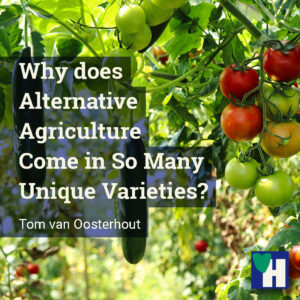
To understand why alternative agriculture comes in so many unique varieties, it is good to review some of the most prominent practices.
All alternative agriculture practices have one thing in common: the drive for sustainability.
This drive is no simple feat because it includes the balancing of totally different and seemingly opposite concerns, such as the supply of sufficient human food, and valuable biodiversity.
Despite the fact that there are still too many people who do not have enough food, and there are still way too many people who eat far too much food, not very much is required to restore the human food balance.
With adequate biodiversity, it is totally the other way around. We urgently need to restore biodiversity on the planet.
Yes, for the sake of biodiversity itself. However, also for the sake of the food we eat.
Some of the links are affiliate links. As an affiliate associate, we earn a commission when you purchase any of the products offered through the shared links at no extra cost for you. This helps us maintain this website.
Table of contents
Why does alternative agriculture come in so many unique varieties?
The differences between the various types of alternative agriculture are caused by the fact that different environmental types and circumstances require different types of farming. Given that sustainability is the common goal, sustainable agriculture requires total assimilation between farming, the environment, and the circumstances.
Agroecology
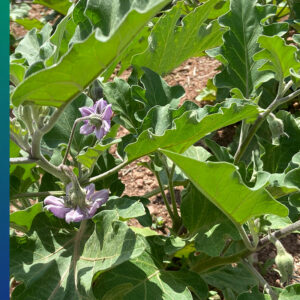
For ecologic horticulture and agriculture, modern applied sciences have become as important as it is for conventional commercial farming.
The objective of ecologic horticulture and agriculture is to attune human food needs to the necessities of biodiversity. This is a very demanding type of balancing act.
The interactions between the soil, the plants, living creatures such as insects, the surrounding environment, social and economic communal life, and agricultural practices need to be managed.
However, at present reconciliation of these different dimensions of ecologic horticulture and agriculture is not sufficient anymore.
Conventional commercial farming fundamentally destroyed the sustainability balance of agriculture. Restoration of almost all conventional agricultural fields from the perspective of agroecology is urgently required.
Related: Conventional Farming versus Organic Farming: the Unfair Comparison.
Regenerative agriculture
One way of restoring the sustainability balance is with regenerative agriculture. This type of agriculture is aimed at rehabilitating food sources with a focus on sustainability.
Regenerative agriculture is aimed at the recovery of topsoil qualities, biodiversity, and water resources, and at the same time the improvement of the quantity and quality of crop yields.
To achieve these aims, regenerative agriculture uses practices such as mixing coexistent crops, crop rotation, cover cropping (crops used as a way to improve the soil, not for food production), and low- or no-tillage cultivation.
As with many alternative agricultural practices, substantial scientific agricultural knowledge and extended practical agricultural management skills are required to implement the principles of regenerative agriculture. Permaculture farming is a good example of regenerative agriculture.
Related: What is Permaculture Farming, and Why can it Save Biodiversity?
Rewilding

Another way of restoring the sustainability balance of agriculture is with rewilding. The advantage of this type of alternative and regenerative agriculture is that it hardly requires agricultural management knowledge and experience.
Moreover, rewilding specifically means to reduce human interference in nature. It is a non-active form of ecosystem restoration, most specifically of ecosystems in which large waters, such as lakes and rivers, and land co-exist.
One of the most important restrictions to rewilding is the hydroelectric and other types of dams. The only way to seriously restore vast ecosystems is by drastically demolishing all dams that hamper the free flow of water.
This may initially not sound very sustainable. However, in the long run, there is no choice. Biodiversity will only restore when most human interferences in nature have been dismantled.
Silvopasture
At first glance, silvopasture seems to be an off-shoot of rewilding. However, silvopasture requires a substantial amount of knowledge and experience with trees, forests, and cattle.
Silvopasture essentially is a way to re-integrate limited amounts of cattle with an interrupted timeframe in a natural environment.
The timeframe is determined by the number of cattle the natural environment can handle and the economic feasibility. It’s obvious that in silvopasture there are many interdependent conditions to manage.
Related: What are the Positive Effects of Deforestation or are the Negative Effects Worse?
Tools for Alternative Agriculture

To demonstrate the amount of knowledge and experience required to be able to manage any type of alternative agriculture, I introduce some of the tools for alternative, ecologically sustainable, agriculture. This also gives this article a practical angle.
Exploiting an ecological garden or field, alone or together with others, to grow a substantial amount of herbs, fruits, and vegetables, requires some specific tools.
Of course, it’s best when these tools correspond with ecological principles. Such tools are not easy to come by. Fortunately, Ecoprac in Spain provides some of these essential tools.
If you can’t find a sustainable tool shop in your neighborhood, ask a local ecologic farmer where he or she buys the tools. All organic farmers we have met so far, are eager to share their knowledge.
Related: Organic Companion Planting for a Healthy Kitchen Garden.
Double handle fork
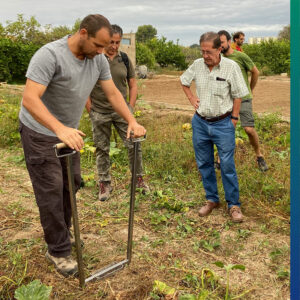
The double handle fork is constructed in such a way that it cannot turn the soil over. It just airs the topsoil.
The worms in the soil are not harmed by this fork because the pins of the fork are round-shaped.
The fork can also be used to harvest carrots, onions, garlic bulbs, leeks, potatoes, and beets. It’s best not to use this fork in topsoil with many stones.
Star roller
The star roller is used to prepare the soil for planting. As with the double handle fork, it can be used to mix organic fertilizer or plant residue in the topsoil.
Multipurpose mobile hoe
This is probably one of the most useful and beautiful tools for small-scale ecological farming ever invented. Different types of equipment can be attached to the multipurpose mobile hoe. Such as the star roller, a weed cutter, and a plow.
The multipurpose mobile hoe is also very good for the back of the farmer. It forces the farmer to stand up straight. At the same time, it produces more traction to the soil than would ever be possible with a handheld hoe.
Weed cutter

What’s in a name? A weed cutter cuts weed, usually between rows of crops. However, a weed cutter is also very handy when the crops are harvested and the plant residues have to be removed.
There are always several sizes available. This is handy because in ecological horticulture and agriculture the crop rows are always mixed and as a consequence, the distances between the rows vary.
Wheelbarrow
Ecoprac does not produce wheelbarrows. From the perspective of ecological practices, this is not a problem, because there is an abundant choice on the market of steel wheelbarrows with a rubber wheel.
There are also many types of wooden wheelbarrows for sale. However, most of them only have a decorative function.
Hoe
The hoe is probably the most ancient horticultural and agricultural tool. The first hoes were made of wood.
Fortunately, the biggest part of most hoes – the shaft – is still made of wood. The actual hoe is made of steel.
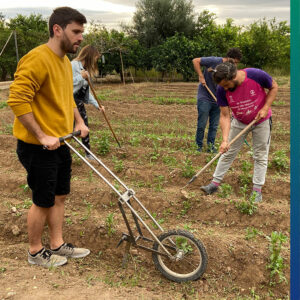
In Spain, it is impossible to tend even the smallest garden without the use of a hoe and a small pickaxe. Due to the draught and the stones, the soil is easily hardened.
Maintenance
All horticultural and agricultural tools need diligent maintenance. Always clean them when ready. Store tools in a dry place.
Hoes, weed cutters, star rollers, and the double handle fork need to be sharp and strong enough to be able to till topsoil.
This also implies, as is always necessary, that all big stones need to be removed from the field before the tools are used.
The size of the stones that have to be removed is obvious when the tools get stuck in the topsoil too often. Or when they need to be sharpened too frequently.
Actually, sustainable horticulture and agriculture on a small scale, even on the scale of the average garden, require as much knowledge and management skills as on the larger scale.
Alternative agriculture comes in many unique varieties
Small sustainable contributions are as important to biodiversity and food security, as the big ones of alternative agriculture.
This article gives only a small overview of the different unique varieties of alternative agriculture. All types have one thing in common, sustainability is their main drive.
Do you know any other types of alternative agriculture? Please tell us in the comment box below.


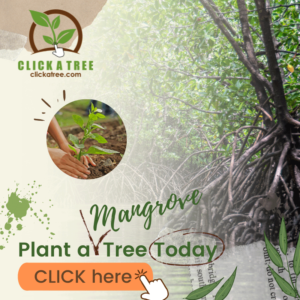
This “To demonstrate the amount of knowledge and experience required to be able to manage any type of alternative agriculture”! I thought having a small ten square meters garden won’t be that challenging. I was so wrong! From making sure the garden is weed-free to watering everything I can safely say I’m exhausted…
Hi Julia,
The really important question is of course: did you enjoy working in your 10 square meters garden? The more you enjoy your garden, the more your exhaust feels like a present.
I prefer to work with a larger field, but with the Covid not many options are available. Perhaps next year. Not many people develop new initiatives. This means I have to develop one myself. That’s okay but takes some research and planning.
Enjoy the fruits of your labor, and thanks for your comment.
Regards,
Tom